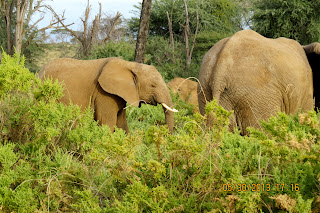This Grevy's zebra was alone, an uncommon sight. It's distinguished by its white belly.
See the zebra? It's on the left.
Members of a troop of baboons.
For a baby baboon's first three months, it clings to its mother's underbelly. For the next three, it rides on its mother's back. After that, it's part of the troop on the ground, staying close to its mother.
Giraffes from a distance.
Getting closer to the giraffes.
Remnants of the weaver bird. The male makes a nest and hangs from it upside down, waiting for a female to come along. The female checks out the nest and decides upon a mate. She lines the inner test and the birds made. Thereafter, the male leaves the female and starts building another nest!
Elephants will eat the sausage tree fruit when it falls to the ground.
The elusive leopard! A good hider. Six safari jeeps searched for this female; we found her just before dusk, with her baby. Leopards hunt at night to avoid competition with lions in the same territory. Leopards are solitary animals; the male leaves the female after breeding, and the female raises her young along.
Waterbucks may graze with other herbivores such as impalas and zebras. Each species has a different way of recognizing predators; with multiple species together, all the animals benefit.
A well-camouflaged chameleon.
A dik dik, the smallest of the antelopes. This is the only antelope that mates for life.
A group of impalas. The group may consist of one male and a number of females and their young. Or it may be a bachelor group - males who have not yet fought and won a group of females. They practice fighting with each other until they have a chance to fight a male with a group of females. The male with females services the females and defends his position against other males. Over time he grows weaker.
On our way out of Samburu on the last day, we had one more game drive. We'd heard a camel had been killed by a lion the day before. The camels live on the other side of the river, but apparently this one had crossed the water, to his peril. The guides talk to each other in the evening, and by radio, so Peter knew where to look to find the remains of the camel.
We passed by a crocodile. These animals have no sweat glands, so they open their mouths to cool off.
As we approached the site of the lion kill, we saw it was clearly marked by a tree absolutely full of vultures.
A short distance away, a cheetah had been sighted in an open area. We found it without much trouble. Sometimes a couple of safari vehicles parked near each other is a good indicator! The cheetah was sitting quite still in the grass near a small tree. Peter told us the cheetah was beginning its hunt. It could see a couple of gazelles about 400 yards away. The best distance between a cheetah and its prey is much shorter; though the cheetah can run 60 miles an hour, it's a sprinter. So the animal approaches stalks its prey quietly and patiently until it's within 33 to 98 feet, a range with a good possibility of success. Over the 15-minute period we watched, the cat moved forward twice, never taking its eyes off the prey ahead. We would like to have stayed to observe the whole hunt, but we had a schedule to keep on departure day from Samburu.




















































